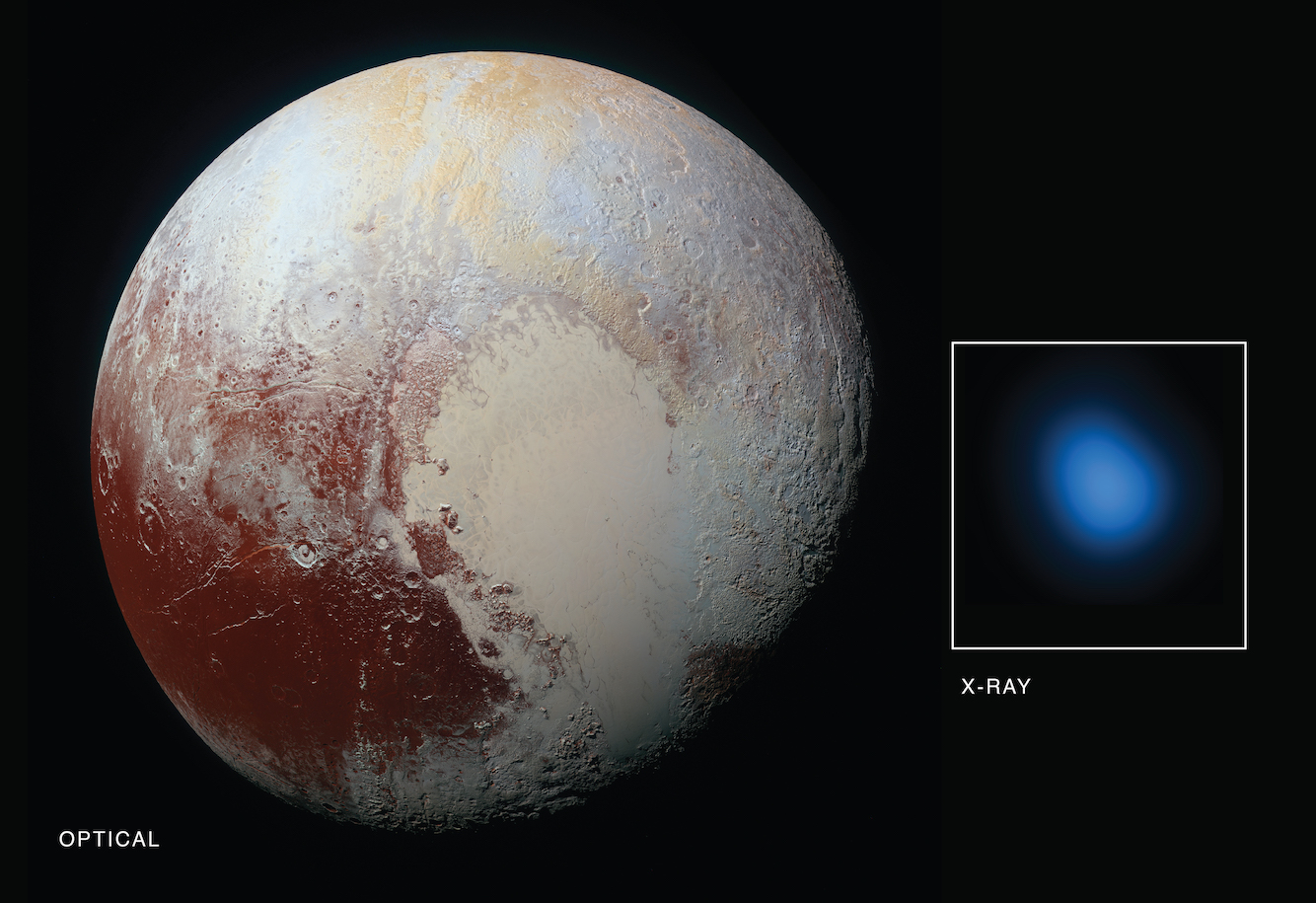
It has been 14 months since the New Horizons spacecraft flew past Pluto and its moons, but data still continues to come in, and new discoveries are still being made. The dwarf planet has surprised scientists by its geological activity, for the most part unexpected for such a small, cold body. Now two new results are adding to the mystery of Pluto: the detection of x-rays emanating from the surface and new evidence that Pluto “spray-paints” the north pole of its largest moon Charon a rusty red color.
First, those x-rays. The detection was made using NASA’s Chandra X-ray Observatory, and then the results were compared to what New Horizons had found during its close flyby. This is the first time that x-rays have been found coming from Pluto.
“We’ve just detected, for the first time, X-rays coming from an object in our Kuiper Belt, and learned that Pluto is interacting with the solar wind in an unexpected and energetic fashion,” said Carey Lisse, an astrophysicist at the Johns Hopkins University Applied Physics Laboratory (APL) in Laurel, Md., who led the Chandra observation team with APL colleague and New Horizons Co-Investigator Ralph McNutt. “We can expect other large Kuiper Belt objects to be doing the same.”
The Chandra space telescope had been aimed at Pluto several times when New Horizons was both approaching and leaving Pluto. X-rays were detected all four times that Chandra was aimed at Pluto, from February 2014 to August 2015.
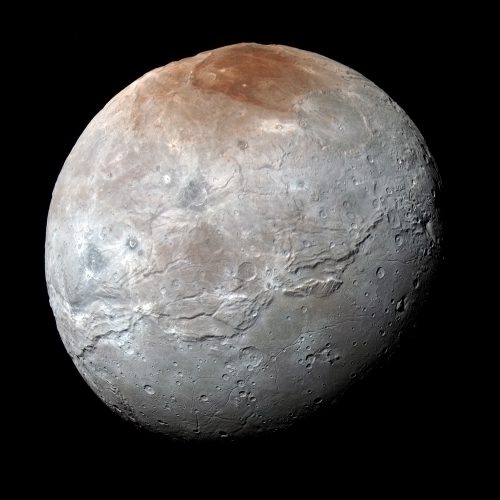
X-rays were not expected to be discovered at Pluto, since it is so small and cold and has no magnetic field. However, there was another way that Pluto could create x-rays: from the interaction between the gases in a planet’s atmosphere and the solar wind coming from the Sun. Pluto’s atmosphere is very thin and tenuous, but apparently is enough to create x-rays. Two decades ago, a similar detection was made of x-rays coming from a comet.
“Before our observations, scientists thought it was highly unlikely that we’d detect X-rays from Pluto, causing a strong debate as to whether Chandra should observe it at all,” said co-author Scott Wolk, of the Harvard-Smithsonian Center for Astrophysics in Cambridge, Mass. “Prior to Pluto, the most distant solar system body with detected X-ray emission was Saturn’s rings and disk.”
One of the instruments on New Horizons, the Solar Wind Around Pluto (SWAP), measured the “bowshock,” where the solar wind first “meets” Pluto and its atmosphere (similar to a shock wave that forms ahead of a supersonic aircraft) and forms a small wake or tail behind the dwarf planet. When the data from Chandra was first examined, however, it showed that the brightness of the x-rays around Pluto was much higher than expected.
It isn’t clear why the difference between the New Horizons and Chandra findings, but for scientists that is just an opportunity to learn more.
“When you have a chance at a once in a lifetime flyby like New Horizons at Pluto, you want to point every piece of glass – every telescope on and around Earth – at the target,” McNutt said. “The measurements come together and give you a much more complete picture you couldn’t get at any other time, from anywhere else.”
Possibilities include a wider and longer tail of gases trailing Pluto than New Horizons had detected, interplanetary magnetic fields focusing more particles than expected from the solar wind into the region around Pluto, or the low density of the solar wind in the outer Solar System at the distance of Pluto may allow for the formation of a doughnut (or torus) of neutral gas centered around Pluto’s orbit.
New Horizons will be able to continue studying the x-ray emissions as part of its extended mission as it continues to travel further into the Kuiper Belt. On Jan. 1, 2019, it will fly past a smaller object called 2014 MU69; it is thought unlikely to detect any x-rays there, but Chandra will be looking at other larger and closer objects in the Kuiper Belt as well.
One of the other surprises of the New Horizons mission was about Pluto’s largest moon, Charon. When the first close-up images were sent back, it was seen that Charon had an unusual reddish blotch at its north pole. The otherwise grayish moon had a reddish polar hood, but why?
As had been surmised, and now substantiated by additional research, the coloring comes from Pluto, as methane gas escapes Pluto’s weak gravity and re-freezes on Charon at its north pole. Ultraviolet light from the Sun then changes the material into heavier hydrocarbons and eventually into reddish organic materials called tholins. In essence, Pluto is “spray-painting” its largest moon.
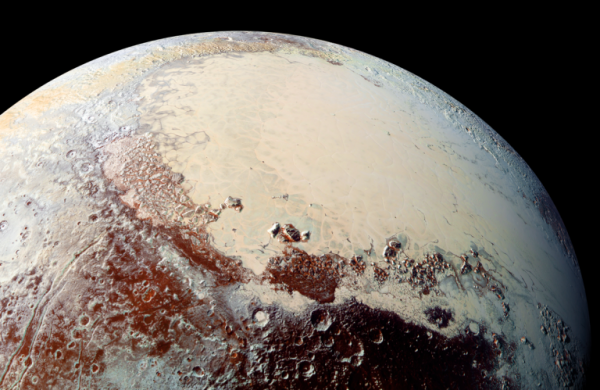
“Who would have thought that Pluto is a graffiti artist, spray-painting its companion with a reddish stain that covers an area the size of New Mexico?” asked Will Grundy, a New Horizons co-investigator from Lowell Observatory in Flagstaff, Ariz., and lead author of the new paper. “Every time we explore, we find surprises. Nature is amazingly inventive in using the basic laws of physics and chemistry to create spectacular landscapes.”
It had been speculated before that Pluto and Charon could “share an atmosphere,” something not yet seen elsewhere in the Solar System.
Analysis of images of Charon taken by New Horizons was combined with computer models of how ice would be expected to evolve at Charon’s poles. What was found was evidence for “extreme weather” at Charon’s poles, where 100 years of continuous sunlight alternate with another century of continuous darkness. Surface temperatures during the dark winters were found to dip to -430 Fahrenheit (-257 Celsius), which is cold enough for methane gas to freeze into solid ice.
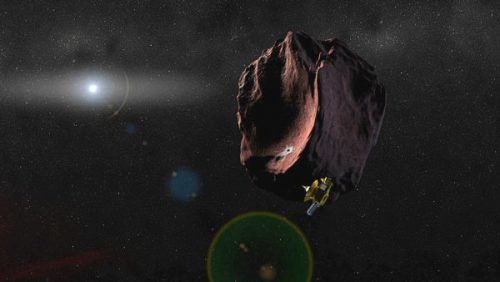
“The methane molecules bounce around on Charon’s surface until they either escape back into space or land on the cold pole, where they freeze solid, forming a thin coating of methane ice that lasts until sunlight comes back in the spring,” Grundy said.
The methane ice then sublimates away, leaving behind the heavier hydrocarbons which then become transformed into the reddish tholins. When spring comes back to the moon, the increasing sunlight converts the methane ice back into a gas.
“This study solves one of the greatest mysteries we found on Charon, Pluto’s giant moon,” said Alan Stern, New Horizons principal investigator from the Southwest Research Institute, and a study co-author. “And it opens up the possibility that other small planets in the Kuiper Belt with moons may create similar, or even more extensive ‘atmospheric transfer’ features on their moons.”
As well as glacier-like plains of smooth nitrogen ice, methane snow on mountain peaks, and possible cryovolcanoes (ice volcanoes), other research now suggests that Pluto may have a subsurface ocean of water, similar to some of the moons in the outer Solar System, such as Europa and Enceladus. Even Charon is thought to have once had an interior ocean, but now likely completely frozen. There is also evidence that Pluto used to have rivers and lakes of liquid nitrogen. How exotic is that?
Pluto is an enigmatic little world, which has yielded many surprises for mission scientists. It may also provide clues as to the characteristics of other rocky bodies in the Kuiper Belt, of which Pluto is the largest, but just one of many. Hopefully more will be learned as New Horizons continues its journey deeper into this dark, distant region of the Solar System. As noted by Stern:
“The Kuiper Belt is a rich scientific frontier. Its exploration has important implications for better understanding comets, the origin of small planets, the Solar System as a whole, the solar nebula, and dusty Kuiper Belt-like disks around other stars, as well as for studying primitive material from our own Solar System’s planet formation era. The exploration of the Kuiper Belt and KBOs like MU69 by New Horizons would transform Kuiper Belt and KBO science from a purely astronomical pursuit, as it is today, to a geological and geophysical pursuit.”
Follow our New Horizons mission page for regular updates.
Want to keep up-to-date with all things space? Be sure to “Like” AmericaSpace on Facebook and follow us on Twitter: @AmericaSpace
Missions » New Horizons »



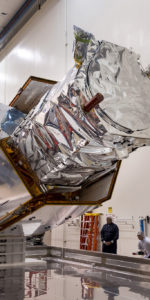
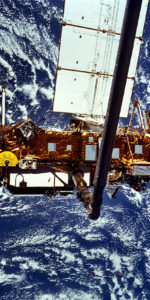
FYI.. “To check this theory, Lisse hopes to look for X-rays around Pluto next month using the European Space Agency’s XMM-Newton satellite”… as per this link.. https://www.newscientist.com/article/2105857-new-horizons-discovery-raises-solar-wind-riddle-around-pluto/
Should ask Lisse about it in Nov, and post a follow up..
Something knocked Uranus over some time ago. I wonder in the inclination of planet Nine, Pluto and Uranus show any relation.
Pluto may have gotten some heavy material from inside an ice giant.